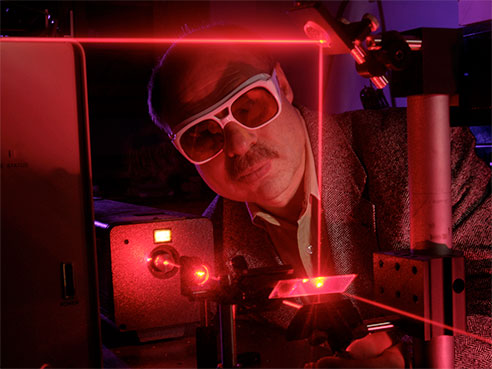 Laser physicist Sergey Mirov, Ph.D., left Russia 22 years ago, after training in Moscow under the 1964 Nobel laureate Aleksandr Mikhailovich Prokhorov and working at the USSR Academy of Sciences.
Laser physicist Sergey Mirov, Ph.D., left Russia 22 years ago, after training in Moscow under the 1964 Nobel laureate Aleksandr Mikhailovich Prokhorov and working at the USSR Academy of Sciences.
Mirov joined the University of Alabama at Birmingham physics faculty in 1993 and created a flourishing research team. Recognition of the resulting laser inventions and more than 20 patents comes today with the naming of Mirov as a fellow of the National Academy of Inventors (NAI). This professional distinction, shared by 170 academic inventors across the United States, is a credit to both his team and the environment at UAB, Mirov says.
“UAB was a young, actively growing university with freedom to think,” Mirov said of his arrival in 1993. “Moreover, the attitude toward people was that it does not matter where you come from. What is important is: Are you talented? Are you professional? Are you eager to work?”
A laser is an optical device that can focus light energy in three domains: the spatial domain, to create a very tight spot of light; the temporal domain, for an extremely fast burst of light; and the spectrum domain, which yields a narrow wavelength of light.
Lasers have three main parts, and Mirov has worked to modify or improve all three. First is the gain material, in which the optical signal is amplified. This material can include dielectric or semiconductor crystals, ceramics, glasses, gases, and liquids. Second is the cavity with mirrors at each end, where positive feedback takes place. Third is an external source of energy that pumps the laser.
| Mirov’s lab in the UAB College of Arts and Sciences is supported by grants totaling $1.5 million. The lab has investigated new types of gain materials and new methods to make those materials. The team has researched new types of cavities that can produce multiple wavelengths of light and different methods of excitation energy — electrical, for example, rather than optical. Mirov also looks for new applications, such as a laser scalpel that can vary its cutting strength as a surgeon operates, or an “optical nose” to detect organic materials. |
Mirov’s lab in the UAB College of Arts and Sciences is supported by grants totaling $1.5 million. The lab has investigated new types of gain materials and new methods to make those materials. The team has researched new types of cavities that can produce multiple wavelengths of light and different methods of excitation energy — electrical, for example, rather than optical. Mirov also looks for new applications, such as a laser scalpel that can vary its cutting strength as a surgeon operates, or an “optical nose” to detect organic materials.
Current research includes tunable lasers that can emit photons in the middle infrared spectrum. This ability has many potential scientific and medical applications, and IPG Photonics — an international company based in Massachusetts, with $648 million in revenue in 2013 — has licensed the invention. Seven IPG Photonics researchers are working on applications at the Innovation Depot, the Birmingham-based business incubator that operates in partnership with UAB.
Mirov says the UAB Research Foundation, now part of the UAB Institute for Innovation and Entrepreneurship, helped protect the intellectual property created by his research. Leona Fitzmaurice, Ph.D., as director of technology transfer for the Research Foundation, negotiated the license with IPG Photonics.
Mirov and his wife, Olga, live in Vestavia Hills. Both of their sons graduated from Vestavia Hills High School. Mike Mirov is a UAB graduate who works with the seven-member IPG Photonics team, and Ilya Mirov is in the master’s program of the UAB Department of Biomedical Engineering.
Mirov said he felt welcomed when he came to America. “The United States is, in a sense, unique. It is a place where a foreigner can feel like a citizen. That only happens in the United States.”
NAI fellows, according to the NAI, are academic inventors “who have demonstrated a prolific spirit of innovation in creating or facilitating outstanding inventions that have made a tangible impact on quality of life, economic development and the welfare of society.”
UAB now has five NAI fellows: Mirov; Richard Marchase, Ph.D., and Dean Sicking, Ph.D., from the class of 2012; and David Briles, Ph.D., and Lawrence DeLucas, O.D., Ph.D., from the class of 2013. Birmingham’s Southern Research Institute has one NAI fellow: Arthur Tipton, Ph.D., 2013.
The 170 fellows named today bring the total number of NAI fellows nationwide to 414, representing more than 150 research universities and governmental and nonprofit research institutions. Included among all of the NAI fellows are 61 presidents and senior leaders of research universities and nonprofit research institutes, 208 members of the other national academies (the National Academy of Sciences, the National Academy of Engineering and the Institute of Medicine), 21 inductees into the National Inventors Hall of Fame, 16 recipients of the U.S. National Medal of Technology and Innovation, 10 recipients of the U.S. National Medal of Science, 21 Nobel laureates, 11 Lemelson-MIT prize recipients, 107 AAAS fellows, and 62 IEEE fellows.
The NAI fellows will be inducted by the Deputy U.S. Commissioner for Patent Operations, from the United States Patent and Trademark Office, during the fourth annual Conference of the National Academy of Inventors, March 20, 2015, at the California Institute of Technology. Fellows will receive a trophy, a newly designed medal and a rosette pin. A plaque on display at the Patent and Trademark Office will list the name and institution of each NAI fellow.
The 2014 NAI fellows will also appear in a full-page announcement in the Jan. 16 “Chronicle of Higher Education” and upcoming issues of “Inventors Digest” and “Technology and Innovation.”